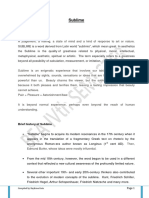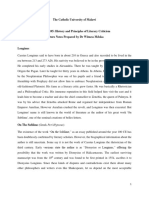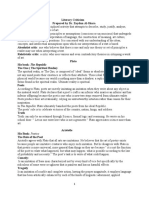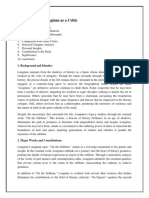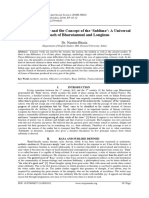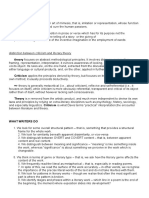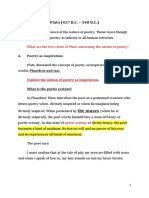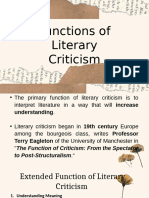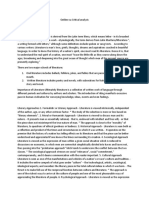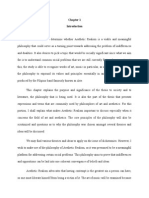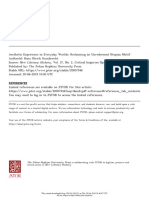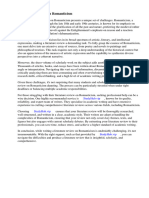0 ratings0% found this document useful (0 votes)
153 viewsLonginus
Longinus
Uploaded by
Basak BucanLonginus was a Greek critic from the 1st century AD. He is considered the first romantic critic and the first comparative critic as he compared Greek and Latin literature. Longinus focused on defining the sublime elements that elevate great works of literature above all others. He identified five ingredients of sublimity: grandeur of thought, powerful emotion, mastery of style and presentation, sensitivity to language and imagery, and skillful ordering of elements. Longinus believed the sublime arises from a writer possessing a great soul and natural gifts, not just technical skill.
Copyright:
© All Rights Reserved
Available Formats
Download as PPTX, PDF, TXT or read online from Scribd
Longinus
Longinus
Uploaded by
Basak Bucan0 ratings0% found this document useful (0 votes)
153 views6 pagesLonginus was a Greek critic from the 1st century AD. He is considered the first romantic critic and the first comparative critic as he compared Greek and Latin literature. Longinus focused on defining the sublime elements that elevate great works of literature above all others. He identified five ingredients of sublimity: grandeur of thought, powerful emotion, mastery of style and presentation, sensitivity to language and imagery, and skillful ordering of elements. Longinus believed the sublime arises from a writer possessing a great soul and natural gifts, not just technical skill.
Copyright
© © All Rights Reserved
Available Formats
PPTX, PDF, TXT or read online from Scribd
Share this document
Did you find this document useful?
Is this content inappropriate?
Longinus was a Greek critic from the 1st century AD. He is considered the first romantic critic and the first comparative critic as he compared Greek and Latin literature. Longinus focused on defining the sublime elements that elevate great works of literature above all others. He identified five ingredients of sublimity: grandeur of thought, powerful emotion, mastery of style and presentation, sensitivity to language and imagery, and skillful ordering of elements. Longinus believed the sublime arises from a writer possessing a great soul and natural gifts, not just technical skill.
Copyright:
© All Rights Reserved
Available Formats
Download as PPTX, PDF, TXT or read online from Scribd
Download as pptx, pdf, or txt
0 ratings0% found this document useful (0 votes)
153 views6 pagesLonginus
Longinus
Uploaded by
Basak BucanLonginus was a Greek critic from the 1st century AD. He is considered the first romantic critic and the first comparative critic as he compared Greek and Latin literature. Longinus focused on defining the sublime elements that elevate great works of literature above all others. He identified five ingredients of sublimity: grandeur of thought, powerful emotion, mastery of style and presentation, sensitivity to language and imagery, and skillful ordering of elements. Longinus believed the sublime arises from a writer possessing a great soul and natural gifts, not just technical skill.
Copyright:
© All Rights Reserved
Available Formats
Download as PPTX, PDF, TXT or read online from Scribd
Download as pptx, pdf, or txt
You are on page 1of 6
LONGINUS (First Century AD)
• Among the manuscripts survived, a Greek work called “On the
Sublime” and this was attributed to “Longinus”, from the first century
AD. The identity of “Longinus” is not known.
• Plato focused on a literary work’s essence. Aristotle focused on the
constituent parts of a work. Horace focused on literary taste. Unlike
them, Longinus focused on single elements of a text. He is the first
critic to define a literary classic.
• He can be considered as not only the first Romantic critic, but also the
first comparative critic. He compared Greek and Latin literature. He
• Plato declares poetic inspiration a divine madness. Longinus’s concept
of the sublime blends inspiration and rhetorical mastery. Thus, a poet
should learn rhetorical devices, but also imitate great writers because
they have great souls. Skill in invention and ordering of the parts of a
whole are important, but sublimity “flashing forth at the right
moment scatters everything before it like a thunderbolt”. Poetry is not
only made of inspiration and writing naturally because nature itself is
also ordered. Unordered sublimity is ineffective.
• Longinus defines the ingredients of sublimity as follows:
1) There is “grandeur of thought” (power of forming great
conceptions). Sublimity is the echo of a great soul. To have great
ideas one must have greatness. It is not possible that men with
mean and servile ideas and aims should produce anything that is
admirable and worthy of immortality. He cites examples from
Homer and shows when a poet is at his best in descriptive writing
and he thinks this is the work of a man of a noble spirit.
2) The second source of sublimity is “powerful emotion”. When this
strong emotion is applied to the material, it fills what is said with
divine exultation. These two constituents of sublimity, “grandeur of
thought and powerful emotion”, derive largely from natural/innate
gifts. The other three constituents are acquired by art.
3) The third is a mastery of many and various devices of style and
methods of presentation.
4) The fourth is acute sensitivity to the qualities of words and to the
potentialities of imagery.
5) The fifth constituent is the orderly placing of words, the ear for
rhythm and pace, sonority and roundedness, aural architecture and
fluency. Indeed this fifth constituent seems to comprehend also
everything that Horace recommended in his emphasis upon
consistency and coherence in overall structure.
• According to Longinus, when our intellects, emotions, and wills
harmoniously respond to a given work of art, we know that we have
been touched by the sublime. He believes that sublimity is
recognizable because within each of us is a power which aspires
toward the great and the noble.
• Longinus emphasized the qualities of imaginative literature which
resist rules and precepts and says that literature cannot be attained
by technical expertise alone. He thinks that the poet needs individual
genius. In this sense, he is against Horace’s ideas of a poet who obeys
literary rules and work hard can become successful. The practice of
literature cannot be reduced to a matter of hard work, persistent self-
criticism, and the disciplined exercise of artistry. He argues that
inspiration, animation, and imaginative reach can give birth to
passages of exultant sublimity that flash upon the reader so as to
electrify and entrance him. Longinus values the power of poetry at its
most intense, not just to satisfy, but to astonish, to enrapture, and to
exalt.
• The concept of sublime is very important to the 18th century criticism.
You might also like
- On The Sublime by LonginusDocument4 pagesOn The Sublime by LonginusFT Kate83% (6)
- The Frailest Thing - L.M. SacasasDocument414 pagesThe Frailest Thing - L.M. SacasasJohn SteltzerNo ratings yet
- On The Sublime - An EssayDocument3 pagesOn The Sublime - An EssayAveek Mukherjee100% (1)
- Longinus-On The SublimeDocument6 pagesLonginus-On The SublimeAbdulRehman88% (26)
- LonginusDocument9 pagesLonginusArin SNo ratings yet
- Write A Note On The Contribution of Longinus. - NeoEnglishDocument3 pagesWrite A Note On The Contribution of Longinus. - NeoEnglishMuhammad Maad RazaNo ratings yet
- Sublime 1Document9 pagesSublime 1Sagar GhodkhandeNo ratings yet
- ENGL 3105 ModuleDocument9 pagesENGL 3105 ModuleRadNo ratings yet
- Literary Criticism-A Brief Survey PDFDocument40 pagesLiterary Criticism-A Brief Survey PDFBelenVettese100% (4)
- Literary Crit Handout Historical 3Document6 pagesLiterary Crit Handout Historical 3Rasha Bani YassenNo ratings yet
- Write A Note On The Contribution of Longinus.: ImaginationDocument2 pagesWrite A Note On The Contribution of Longinus.: Imaginationsaadi mziriNo ratings yet
- A House For MR Biswas StudyguideDocument6 pagesA House For MR Biswas StudyguideShankar D P ShankarNo ratings yet
- Historical Background of The Sublime LonginusDocument12 pagesHistorical Background of The Sublime Longinuscajandiggenalyn66No ratings yet
- Source of SublimityDocument7 pagesSource of SublimitySonal Sahu100% (2)
- LonginusDocument11 pagesLonginusSaeed khan67% (6)
- Longinus As A CriticDocument6 pagesLonginus As A CriticJuma Gull0% (1)
- Source Submility Full NotesDocument3 pagesSource Submility Full NotesSonal SahuNo ratings yet
- 07 Chapter 2Document62 pages07 Chapter 2Muhammad Asim Hafeez ThindNo ratings yet
- Literary Criticism Lecture Four and FiveDocument27 pagesLiterary Criticism Lecture Four and FiveSami ktkNo ratings yet
- Literary Criticism NotesDocument23 pagesLiterary Criticism Notesyagmuruzan6No ratings yet
- Basic Approaches To Literary InterpretationDocument15 pagesBasic Approaches To Literary InterpretationIin FitriNo ratings yet
- Horace and LonginusDocument27 pagesHorace and LonginusWael M. Alsawi100% (7)
- Literary Criticism (1)Document9 pagesLiterary Criticism (1)englitloreNo ratings yet
- On The Sublime,: - Roman Classicism: Longinus and HoraceDocument2 pagesOn The Sublime,: - Roman Classicism: Longinus and HoraceAhmed AloqailiNo ratings yet
- Revision 401Document12 pagesRevision 401piskins305No ratings yet
- Lecture One Classical Criticism PlatoDocument7 pagesLecture One Classical Criticism PlatoJana WaelNo ratings yet
- A Historical Survey of Literary CriticismDocument35 pagesA Historical Survey of Literary CriticismLisa LujánNo ratings yet
- RasaDocument3 pagesRasaAditi VaidNo ratings yet
- Sublime From Longinus To BurkeDocument6 pagesSublime From Longinus To Burkekaushik_ranjan_2No ratings yet
- Summary "On The Sublime" by LonginusDocument2 pagesSummary "On The Sublime" by Longinussp0017official100% (1)
- History of CriticsDocument32 pagesHistory of CriticsNariţa GeorgianaNo ratings yet
- PlatoDocument7 pagesPlatoRehab FaroukNo ratings yet
- Plato's Literary CriicismDocument8 pagesPlato's Literary CriicismDevika MenonNo ratings yet
- Romantic CriticismDocument15 pagesRomantic CriticismLet's Be The DifferenceNo ratings yet
- Lit Theory Texts SummaryDocument11 pagesLit Theory Texts Summaryj.munozcistNo ratings yet
- ColeridgeDocument15 pagesColeridgeAdnan KhanNo ratings yet
- English Major ReviewerDocument21 pagesEnglish Major ReviewerJayareNo ratings yet
- Literary Criticism M2Document15 pagesLiterary Criticism M2akosi.ebonNo ratings yet
- On The Sublime: Longinus Longinus Is Regarded As The First Romantic Critic: J D ScottDocument6 pagesOn The Sublime: Longinus Longinus Is Regarded As The First Romantic Critic: J D ScottManu James0% (1)
- 21st CLPW - Week 1Document61 pages21st CLPW - Week 1Raven RoxasNo ratings yet
- Literary Critism - PlatoDocument10 pagesLiterary Critism - Platoaaradhyasingh1291No ratings yet
- Fundamentals of LiteratureDocument28 pagesFundamentals of LiteratureTesfu Hetto67% (3)
- Técnicas What Is LiteratureDocument6 pagesTécnicas What Is LiteraturecandelacruzNo ratings yet
- M.A Literary Criticism CompletedDocument42 pagesM.A Literary Criticism CompletedNeelamNo ratings yet
- A Historical Survey of Literary CriticismDocument4 pagesA Historical Survey of Literary CriticismKring RosseNo ratings yet
- Majorship Area: English Focus: Literary Criticism LET CompetenciesDocument9 pagesMajorship Area: English Focus: Literary Criticism LET CompetenciesEd-Jay RoperoNo ratings yet
- Outline Sa Critical Analysis Week 1Document3 pagesOutline Sa Critical Analysis Week 1Ben Jethro Palermo PascuaNo ratings yet
- Session 4: Critical Analysis: Definition of Literary Criticism or Criticism of Literature?Document17 pagesSession 4: Critical Analysis: Definition of Literary Criticism or Criticism of Literature?Yonn Me Me KyawNo ratings yet
- Rhetoric and Longinus' On The SublimeDocument4 pagesRhetoric and Longinus' On The SublimeweepingmeadowNo ratings yet
- Eng 4: Philippine LiteratureDocument5 pagesEng 4: Philippine Literaturejanela rodrigoNo ratings yet
- Survey LitDocument37 pagesSurvey LitSilva, Phoebe Chates Bridget B.No ratings yet
- Samuel Taylor Coleridge Biographia LiterariaDocument26 pagesSamuel Taylor Coleridge Biographia LiterariaMuneeb Tahir Saleemi100% (1)
- Muhamad Saqib Assignment Literary TheoryDocument4 pagesMuhamad Saqib Assignment Literary TheorySaqib RanaNo ratings yet
- FormalismDocument26 pagesFormalismFaina Rose CasimiroNo ratings yet
- Reviewer in 21ST Century LiteratureDocument13 pagesReviewer in 21ST Century LiteratureNathaniel JabinalesNo ratings yet
- Longinus On The SublimeDocument8 pagesLonginus On The SublimeAbhay kumar patelNo ratings yet
- Paper 302C (Long) : " .Emotion Recollected in Tranquillity"-Critical AppreciationDocument4 pagesPaper 302C (Long) : " .Emotion Recollected in Tranquillity"-Critical AppreciationDas EducationNo ratings yet
- DEG21 Literary CriticismDocument247 pagesDEG21 Literary CriticismOmer Sultan SayadNo ratings yet
- On The Sublime (Longinus)Document30 pagesOn The Sublime (Longinus)FT Kate80% (5)
- Vandenabeele, B. - 'Schopenhauer, Nietzsche, and The Aesthetically Sublime'Document18 pagesVandenabeele, B. - 'Schopenhauer, Nietzsche, and The Aesthetically Sublime'Mauro SarquisNo ratings yet
- Thesis ManuscriptDocument36 pagesThesis ManuscriptLianChenNo ratings yet
- Sublimity PDFDocument14 pagesSublimity PDFAlicia ChristieeNo ratings yet
- (George Pattison) Kierkegaard, Religion and The NiDocument273 pages(George Pattison) Kierkegaard, Religion and The Nimarkus2298No ratings yet
- Beauty and The Cosmos - David E. Cooper PDFDocument12 pagesBeauty and The Cosmos - David E. Cooper PDFjusrmyrNo ratings yet
- Lombard - 2018 - Thoreau and The CapitaloceneDocument15 pagesLombard - 2018 - Thoreau and The CapitaloceneDaniloMenezesNo ratings yet
- Contemporary Environmental SublimeDocument18 pagesContemporary Environmental SublimeSofia VermelhoNo ratings yet
- Smat 23Document4 pagesSmat 23Chandru TnNo ratings yet
- 646 Words Essay For Students On Beauties of NatureDocument1 page646 Words Essay For Students On Beauties of NatureAsad KaleemNo ratings yet
- Costas Douzinas - Sublime LawDocument13 pagesCostas Douzinas - Sublime LawLucas SantosNo ratings yet
- Gumbrecht-Estetica Cotidiana.Document21 pagesGumbrecht-Estetica Cotidiana.Antropoteatro EntropoNo ratings yet
- Plants As Objects - Challenges For An Aesthetics of FloraDocument16 pagesPlants As Objects - Challenges For An Aesthetics of Floramayara nardoNo ratings yet
- 2013 - May - Human Landscape Perception AONB High Weald Eugenie Van HeijgenDocument144 pages2013 - May - Human Landscape Perception AONB High Weald Eugenie Van HeijgenmarianaNo ratings yet
- The Sublime of The HyperrealDocument3 pagesThe Sublime of The Hyperrealvladaalister100% (1)
- Literature Review On RomanticismDocument7 pagesLiterature Review On Romanticismjcrfwerif100% (1)
- Get Kant, Shelley and The Visionary Critique of Metaphysics O. Bradley Bassler Free All ChaptersDocument57 pagesGet Kant, Shelley and The Visionary Critique of Metaphysics O. Bradley Bassler Free All Chaptersdikolejevoun100% (2)
- Paddison 2010Document24 pagesPaddison 2010GrandeBoiNo ratings yet
- Comprehending Abstract Themes in Avant-Garde Film (Deren / Lynch)Document31 pagesComprehending Abstract Themes in Avant-Garde Film (Deren / Lynch)TXHNo ratings yet
- A Philosophical Enquiry Into The Origin of Our Ideas of The SublimeDocument6 pagesA Philosophical Enquiry Into The Origin of Our Ideas of The SublimeM. EwadhNo ratings yet
- SR 201206183301Document10 pagesSR 201206183301khalid hayatNo ratings yet
- Jocb 231Document6 pagesJocb 231Rafaela GoncalvesNo ratings yet
- Environmental AestheticsDocument16 pagesEnvironmental AestheticsRasheed ArshadNo ratings yet
- Literary Criticism Synopsis PDFDocument32 pagesLiterary Criticism Synopsis PDFAminNo ratings yet
- Brouwer-Toru Thesis Hum 2016 Du Plessis HarmDocument99 pagesBrouwer-Toru Thesis Hum 2016 Du Plessis HarmSantiago PariasNo ratings yet
- A Short History of Literary CriticismDocument303 pagesA Short History of Literary CriticismAliney Santos Gallardo100% (2)
- Joys Joanne CarolDocument543 pagesJoys Joanne CarolshadowwyNo ratings yet
- Manchester, 25 September 2004 - 21 November 2004Document13 pagesManchester, 25 September 2004 - 21 November 2004Iqrar RizviNo ratings yet
- MCCORMACK - Art, Emergence, SublimeDocument15 pagesMCCORMACK - Art, Emergence, SublimeLionhardyNo ratings yet
- Kaplan - Reading RicoeurDocument0 pagesKaplan - Reading RicoeuryopertNo ratings yet






